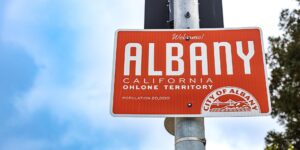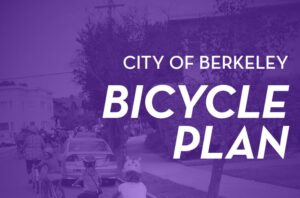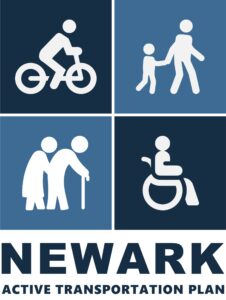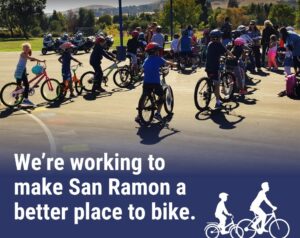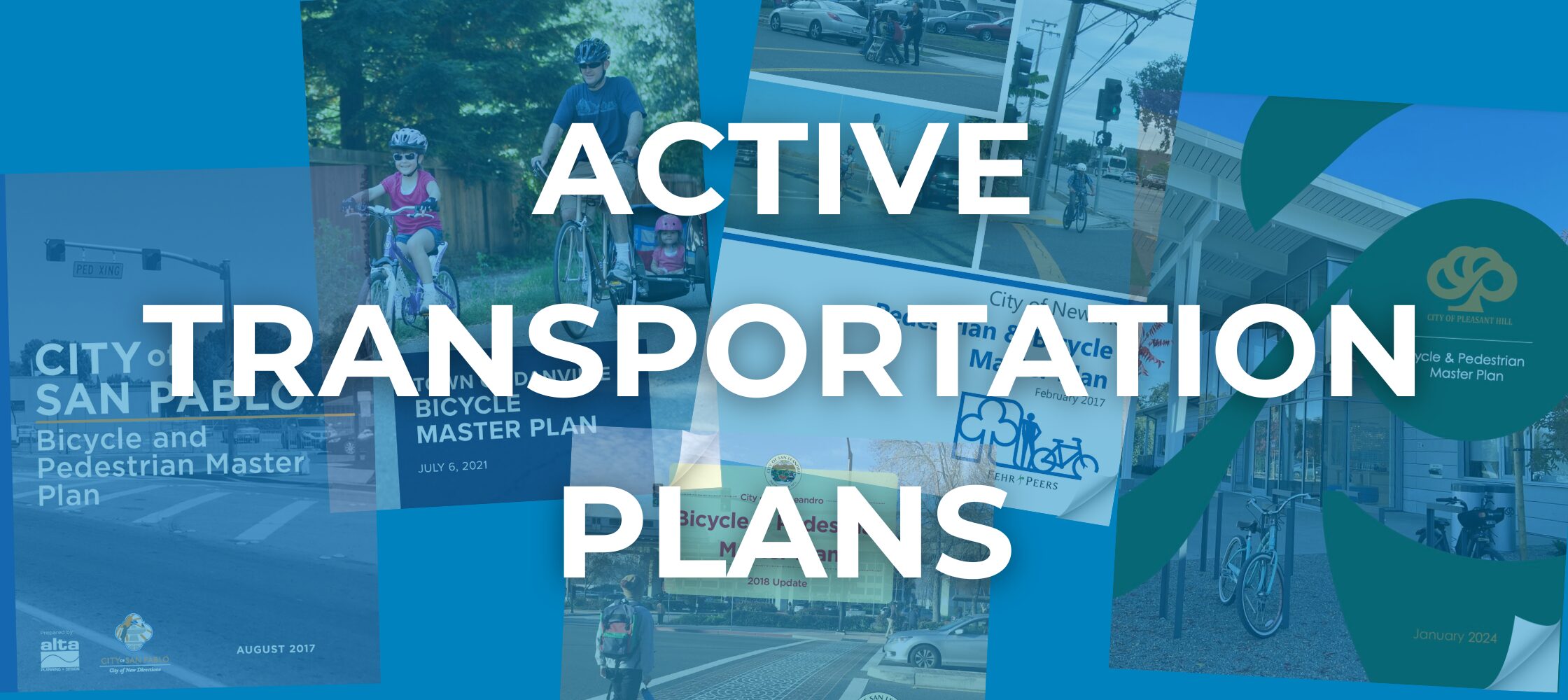
Biking, walking, and active transportation plans are critical tools for developing bikeway networks and prioritizing investments.
This resource provides info about East Bay bike plans to help inform your advocacy, and how to get involved with updates.
East Bay Bike Plan LIST
The following list provides links to bicycle or active transportation plans for every East Bay jurisdiction, as well as the year it was last updated, and any info about any update process currently underway.
Generally, bike plans should be updated every 5 years or so to remain relevant and provide support for competitive infrastructure grant applications. Bike plans that have been updated within the past 5 years are color coded green, those due for an update are colored yellow, and those overdue are shown in red. Jurisdictions that are part of a county’s unincorporated area, or those without their own bike plan, are covered via that county’s bike plan.
Links to separate pedestrian plans (if available) and Local Road Safety Plans which identify and prioritize investments related to road safety for all modes of travel, are provided separately.
Warning: Some of these links go directly to large PDF files.
What is a Bike Plan?
Bike, pedestrian, and active transportation plans typically do the following:
Provide a report on “existing conditions” related to facilities (bike lanes, trails, sidewalks, etc) and programs already provided, crash rates/types/locations, current rates of biking and walking, and sometimes surveys or interviews with individuals about why they do/don’t bike or walk and what barriers they face.
Offer definitions of different types of facilities, treatments, programs, and what they’re for.
Publish information on the plan’s process, detailing the outreach and communications process, the input that was received and from who.
- Provide a list and/or map of recommended programs, policies, and facilities to achieve safety and achieve goals laid out earlier in the plan, prioritized based on importance and with an estimated funding need for implementation.
Per state law (Streets and Highways Code section 891.2) a bike plan is also required to include eleven specific elements, including things such as maps for existing/proposed bikeways and parking facilities, info about safety programs, as well as details on community involvement in the plan development.
Some important elements every bike plan should include are the following:
- A continuous, regional network of “low stress” and “all ages” facilities.
This usually includes physically protected on-street bikeways, off-street bike/walk trails, and narrow neighborhood streets with significant design to slow car speeds and reduce non-local car traffic. This should also include treatments at intersections to enable safe and convenient through movements and turns for bike riders. - Progressive policy and planning recommendations for secure bike parking design standards and funding, both for use by the general public as well as for implementation with new development.
- Recommendations for design standards on “low stress” neighborhood bikeways to include physical and continuous traffic calming (speed humps, traffic circles, diverters, etc) throughout each corridor.
- Program recommendations for the jurisdiction to support and fund activities such as free bike rides, classes, events like Bike to Work Day, community bike shops and maintenance programs, and other opportunities for encouraging individuals and organizations to bike.
- Policy recommendations around “quick build” installations in response to all serious injury or fatal bike/walk crashes, with short term mitigations to reduce risk at that location.
Bike Plan Updates Underway
Below is a list of East Bay bicycle and active transportation plans that are currently in the process of being updated.
Click through the links to the project pages to learn more and get involved.
The City of Albany is currently updating its Active Transportation Plan, which was developed in 2012 and last updated in 2019.
The new Active Transportation Plan is an opportunity to reaffirm community priorities, analyze new data, and incorporate the latest technology and best practices.
The update process is expected to continue through Fall 2025, with several opportunities for community input and involvement. Sign up for the project mailing list at the bottom of the page to receive updates and notifications.
Provide input via an online map and survey here
This effort is an update to Berkeley’s 2017 bicycle plan, to identify opportunities for changes and improvements to the previous recommendations around bike infrastructure, policies, and programs.
Your input will help the project team develop a new bicycle policy framework that will ultimately guide the city’s priorities and decision making, all while making it easier, safer, and more comfortable to bike and roll in Berkeley.
Once the Plan Update is complete, it will include a list of project recommendations that will help Berkeley:
- Address locations that currently make it challenging to bicycle or roll
- Build upon its “low-stress” network of bicycling and rolling routes
- Make bicycling and rolling safer and more comfortable for people of all races, ethnicities, incomes, ages, and abilities
Freeway interchanges and state-owned surface streets (like parts of San Pablo Ave, Mission Blvd, International Blvd, Ashby Ave, and others) are among the most dangerous places for biking in the East Bay.
Help Caltrans prioritize improvements via their bike plan update by adding comments to this map, and favoriting other people’s comments.
The Newark Active Transportation Plan is an opportunity to advance infrastructure that supports walking, biking, and rolling throughout the City.
The Newark Active Transportation Plan is an update to the 2017 Pedestrian and Bicycle Master Plan, a comprehensive planning document that develops and prioritizes infrastructure improvements to support walking, biking, and rolling (e.g. mobility devices, skateboards, and scooters) in the City.
The Active Transportation Plan will recommend improvements that expand a safe, comfortable, and connected active transportation network for all ages and abilities.
The Pinole Active Transportation Plan (ATP) aims to create a comprehensive vision for enhancing pedestrian and cycling experiences in Pinole, catering to individuals of diverse ages and abilities with the goal of decreasing Vehicle Miles Traveled (VMTs).
Click through to learn more, add your comments via the web map and survey, and find dates for in-person pop-up events around Pinole.
Provide input via an online map here

The City of Pleasanton is updating its Bicycle and Pedestrian Plan in 2025-2026 to help shape the future of walking, biking, and rolling in Pleasanton. This update builds on the plan adopted in 2018 and will include completed projects, current community needs, and new ideas in street design.
Click through to learn more, add your comments via the web map and survey, complete a survey, and sign up for the notification list.
The San Ramon Public Works Department has started the process of updating the San Ramon Bicycle Master Plan (BMP), which was last updated in 2018.
The BMP serves as a guide for the development of safe and accessible bikeways and paths within San Ramon.
The purpose of the Bicycle Master Plan Update is to review the 2018 plan, identify what has been implemented since then, and develop refreshed strategies to improve safety and access and to encourage bicycling throughout the city.
This update will outline updated goals, policies, physical improvements, educational programs, and funding/implementation strategies.


